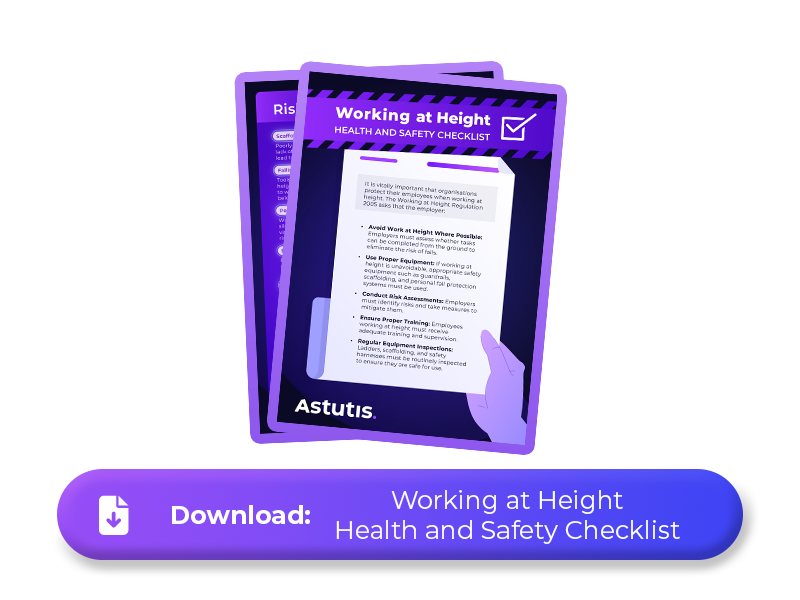Working at Height Regulations Guide for Construction | WAHR
Businesses and safety professionals in the UK construction industry have several legal responsibilities to protect employees from falls from height. The Working at Height Regulations 2005 (WAHR) is the primary piece of legislation governing that you must be aware of. Failure to comply can lead to devastating consequences for victims, colleagues and their employers.
What Is Working at Height?
Working at height means working in any place or location where there is a possibility that a person could fall a distance that could cause them harm or injury. You are considered to be working from height when you:
- Work above ground/floor.
- Could potentially fall from an edge, through an opening or from a fragile surface.
- Could fall from ground level into an opening in the floor or a hole in the ground.
Working at height excludes slips or trips on the same level, as a fall from height must entail a person falling from one level to a lower level. Walking up and down a permanent staircase in a building.
Working at Height Regulations in the UK
The Working at Height Regulations 2005 apply to all work at height, where there is a risk of a fall liable to cause personal injury. Employers, facility managers, and self-employed individuals must take necessary precautions to prevent falls and ensure safety.
Key requirements of the Working at Height Regulations include:
- Avoid Work at Height Where Possible: Employers must assess whether tasks can be completed from the ground to eliminate the risk of falls.
- Use Proper Equipment: If working at height is unavoidable, appropriate safety equipment such as guardrails, scaffolding, and personal fall protection systems must be used.
- Conduct Risk Assessments: Employers must identify risks and take measures to mitigate them.
- Ensure Proper Training: Employees working at height must receive adequate training and supervision.
- Regular Equipment Inspections: Ladders, scaffolding, and safety harnesses must be routinely inspected to ensure they are safe for use.
Failure to comply with these regulations can lead to legal consequences, fines, and, most importantly, serious injuries or fatalities.
Other Relevant Legislation
In addition to the Working at Height Regulations 2005, several other pieces of legislation influence working at height safety in the UK:
Health and Safety at Work etc. Act 1974
The Health and Safety at Work etc. Act 1974 places a duty on employers to ensure the health, safety, and welfare of employees, including those working at height.
Management of Health and Safety at Work Regulations 1999
The Management of Health and Safety at Work Regulations 1999 require employers to conduct risk assessments and implement necessary control measures to protect workers from potential hazards.
Employers and site managers must consider these regulations alongside the Working at Height Regulations 2005 to ensure full compliance and create a safe working environment.
Assessing Risks for Construction Jobs That Require Working at Height
Risk assessments are crucial in identifying hazards and implementing safety measures when working at height. Employers must evaluate the work environment, potential hazards, and the effectiveness of control measures.
Common Risks When Working from Height
Some of the most common risks associated with working at height in construction include:
- Falls from Ladders: Using unstable or poorly positioned ladders increases the risk of falls.
- Fragile Roofs: Roofs made of brittle materials, such as asbestos cement or plastic, can break underweight.
- Scaffold Collapses: Poorly erected scaffolding or a lack of proper maintenance can lead to structural failures.
- Falling Objects: Tools and materials falling from height can pose a severe hazard to workers and pedestrians below.
- Poor Weather Conditions: Wind, rain, and ice can create slippery surfaces and reduce visibility, increasing accident risks.
Falls From Height Control Measures
To minimise the risks associated with working at height, the following control measures should be implemented:
- Use of Fall Prevention Systems: Guardrails, barriers, and work platforms can prevent falls.
- Personal Protective Equipment (PPE): Safety harnesses, helmets, and non-slip footwear provide additional protection.
- Safe Use of Ladders and Scaffolds: Ladders should be stable and positioned correctly, while scaffolding must be built by competent personnel. For a full inspection checklist for ladders, we have a guide available.
- Edge Protection: Roofs and platforms should have guardrails and toe boards to prevent falls.
- Proper Training and Supervision: Workers must be trained in safe working practices and the correct use of safety equipment.
- Emergency Procedures: Plans must be in place for rescue operations in case of a fall.
We've also condensed this information into an easy-to-read infographic for you to download below.
Risk Assessment Template
A structured risk assessment template can help ensure a thorough evaluation of working at height hazards. Download our free risk assessment template and guide, applicable for all industries, including construction.
Health and Safety Training for Working at Height
The NEBOSH National General Certificate is an excellent course available for UK site managers, health and safety professionals and senior personnel to fully understand the breadth of hazards and risks on a construction site. It offers a whole range of benefits for both employees and employers, to help keep the workplace safe.
Head over to the course page below to find out more about the course, try a free demo and discover how it can benefit your organisation.

Real Life Stories






